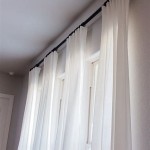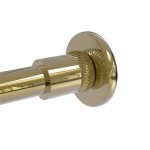Hang Up Curtains Without Drilling: Damage-Free Solutions
Hanging curtains is a straightforward method to enhance the aesthetic appeal of a room, control light infiltration, and improve privacy. However, the prospect of drilling holes, particularly in rented spaces or when seeking to minimize wall damage, can be daunting. Fortunately, several effective and practical solutions exist for hanging curtains without resorting to drills, offering a damage-free alternative for various window types and curtain styles.
This article explores several methods for hanging curtains without drilling, detailing the materials required, the step-by-step process, and the advantages and disadvantages of each approach. It aims to provide comprehensive information to empower individuals to choose the most suitable method based on their specific needs and circumstances.
Understanding the Limitations and Considerations
Before delving into specific techniques, it is crucial to acknowledge the limitations of drill-free curtain hanging solutions. These limitations primarily revolve around weight capacity and the type of curtain heading being used. Lightweight curtains made of sheer or voile fabric pose minimal challenges, whereas heavier drapes constructed from thick materials like velvet or blackout fabrics require more robust support. Similarly, curtains with grommets or rod pockets generally fare better with these methods than those with complicated pleats, which often require specialized hardware to distribute weight evenly.
Furthermore, the surface to which the curtain hardware will be attached significantly impacts the success of these methods. Smooth, clean surfaces like painted drywall or finished wood are ideal for adhesives and tension rods, whereas textured or uneven surfaces might compromise the bond or stability. Proper surface preparation is paramount to ensure a secure and long-lasting hold. Finally, consider the overall aesthetic. While some drill-free solutions are discreet, others are more visible and may not align with the desired room decor.
Utilizing Tension Rods
Tension rods represent one of the simplest and most widely used methods for hanging curtains without drilling. These rods utilize internal spring mechanisms to expand and create pressure against the inside of the window frame, providing a secure hold without any permanent fixtures. Tension rods are particularly well-suited for lightweight to medium-weight curtains and are ideal for renters or those seeking a quick and easy solution.
The installation process is relatively straightforward. First, measure the width of the window frame where the rod will be placed. Then, extend the tension rod slightly beyond this measurement, typically by an inch or two on each side. Position the rod inside the window frame at the desired height, ensuring it is level using a level tool. Continue to extend the rod until it is firmly pressed against both sides of the frame. Periodically check the rod's stability and make adjustments as needed to prevent slippage.
While convenient, tension rods are not without their drawbacks. They are generally less robust than traditional curtain rods and may struggle to support heavier curtains. The rod may also slip or fall if the window frame is not perfectly smooth or if the weight distribution is uneven. Moreover, the visible nature of the rod might detract from the overall aesthetic in some cases. To mitigate these issues, opt for high-quality tension rods with a wider diameter and non-slip grips. For heavier curtains, consider using multiple tension rods positioned closer together to distribute the weight more effectively.
Employing Adhesive Hooks and Rods
Adhesive hooks and rods offer another drill-free option for hanging curtains, relying on strong adhesives to secure the hardware to the wall or window frame. These products are available in various sizes and styles, catering to different curtain weights and aesthetic preferences. Adhesive hooks are particularly useful for hanging lightweight valances or sheer curtains, while adhesive rods can support slightly heavier fabrics.
The installation process involves carefully cleaning the surface where the hooks or rods will be attached, typically with rubbing alcohol to remove any dirt, dust, or grease. Peel off the backing from the adhesive pads and firmly press the hooks or rods onto the designated location. It is essential to follow the manufacturer's instructions regarding curing time, allowing the adhesive to fully bond before hanging the curtains. This waiting period, usually ranging from 24 to 72 hours, ensures maximum adhesion and prevents premature failure.
The efficacy of adhesive hooks and rods hinges on the quality of the adhesive and the condition of the surface. Cheap or poorly formulated adhesives may fail to provide adequate support, leading to the curtains falling down. Similarly, attaching the hooks or rods to textured or damaged surfaces can compromise the bond. To ensure optimal results, select high-quality adhesive products from reputable brands and thoroughly prepare the surface before installation. Consider using additional adhesive reinforcement, such as construction adhesive or double-sided mounting tape, for heavier curtains or challenging surfaces. However, bear in mind that using stronger adhesives might leave residue or damage when removed.
Using Magnetic Curtain Rods
Magnetic curtain rods provide a unique solution for hanging curtains on metal surfaces, eliminating the need for drilling or adhesives. These rods utilize powerful magnets to attach directly to steel or iron window frames, offering a secure and damage-free installation. Magnetic rods are particularly well-suited for metal doors, refrigerators, or any other magnetic surface where traditional curtain rods cannot be easily installed.
The installation process is exceptionally simple. Position the magnetic rod at the desired height on the metal surface and ensure it is level. The magnets will automatically attach and hold the rod in place. Adjust the position as needed to achieve the desired look. Magnetic curtain rods are typically adjustable in length, allowing them to fit a range of window sizes.
The primary limitation of magnetic curtain rods is their dependence on a magnetic surface. They cannot be used on drywall, wood, or aluminum frames. Moreover, the weight capacity of magnetic rods is typically lower than that of tension rods or adhesive rods, making them unsuitable for heavy curtains. The strength of the magnets can also vary significantly between different brands and models, so it is crucial to choose a high-quality rod with sufficiently powerful magnets to support the intended curtains. Furthermore, be mindful of the potential for the magnets to scratch or damage the metal surface. Consider using protective felt pads or rubber coatings on the magnet surfaces to prevent any scratches or marks.
Exploring Alternative Solutions: Command Strips, Fabric Tape, and Curtain Alternatives
Beyond the aforementioned methods, several alternative approaches can be employed to hang curtains without drilling, albeit with varying degrees of suitability and effectiveness. Command strips, for instance, utilize removable adhesive technology to attach hooks or rods to the wall. While relatively easy to use, Command strips are best suited for lightweight fabrics and require careful surface preparation to ensure a strong bond. It's imperative to follow the weight limits specified by the manufacturer meticulously to prevent the hangers from failing. They may not be the most aesthetically pleasing option due to the visibility of the strips themselves.
Fabric tape, also known as hemming tape, can be used creatively to attach lightweight curtains directly to the window frame or wall. Double-sided fabric tape is applied to the edge of the curtain and then pressed onto the desired surface. This method is primarily suitable for sheer or voile curtains and offers a very minimalist look. However, fabric tape might leave residue on the wall or window frame upon removal and may not provide a very secure hold. It's also not ideal for curtains that need frequent washing.
Finally, consider exploring curtain alternatives that do not require traditional hanging methods. Window films, for example, can provide privacy and light control without the need for curtains. These films are applied directly to the glass surface and offer a range of patterns and opacities. Roman shades or roller shades can also be installed using spring-loaded mechanisms or adhesive mounting brackets, eliminating the need for drilling. These options offer a more permanent and streamlined solution for window coverings. Another often over-looked solution is to simply install the curtain rail higher up the wall, using existing holes from picture hooks or other decorations. This might not be ideal but is a simple solution for some situations.
Ultimately, the selection of the most appropriate method for hanging curtains without drilling depends on a multitude of factors, including the weight of the curtains, the type of window frame and wall surface, the desired aesthetic, and the level of permanence sought. By carefully evaluating these considerations and exploring the diverse range of available solutions, individuals can successfully hang curtains without compromising the integrity of their walls or incurring the inconvenience of drilling.

How To Hang Up Curtains Without Drilling Holes

How To Hang A Curtain Rod Without Drilling Into The Wall

How To Hang Curtains Without Drilling 2 Solutions

How To Hang Curtains Without Drilling

How To Hang Curtains Without Drilling 2 Solutions

How To Hang Curtains Without Putting Holes In The Wall

How To Hang A Curtain Rod Without Drilling Into The Wall

How To Hang Curtains Over Blinds The Easy Way

Er Friendly Curtains How To Hang Them Without Drilling Draper And Kramer Incorporated

Er Friendly Curtains How To Hang Them Without Drilling Draper And Kramer Incorporated








